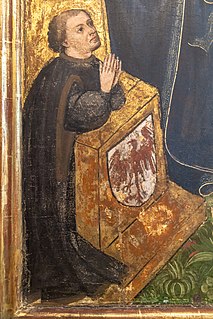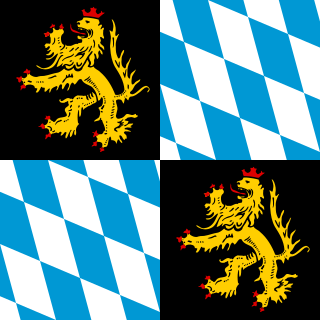
Frederick was the last Burgrave of Nuremberg from 1397 to 1427, Margrave of Brandenburg-Ansbach from 1398, Margrave of Brandenburg-Kulmbach from 1420, and Elector of Brandenburg from 1415 until his death. He became the first member of the House of Hohenzollern to rule the Margraviate of Brandenburg.
The history of Bavaria stretches from its earliest settlement and its formation as a stem duchy in the 6th century through its inclusion in the Holy Roman Empire to its status as an independent kingdom and finally as a large Bundesland (state) of the Federal Republic of Germany. Originally settled by Celtic peoples such as the Boii, by the 1st century BC it was eventually conquered and incorporated into the Roman Empire as the provinces of Raetia and Noricum.
Duke John II of Bavaria-Munich, , since 1375 Duke of Bavaria-Munich. He was the third son of Stephen II and Elizabeth of Sicily.

Stephen II was Duke of Bavaria from 1347 until his death. He was the second son of Emperor Louis IV the Bavarian by his first wife Beatrice of Silesia and a member of the Wittelsbach dynasty.
Frederick was Duke of Bavaria from 1375. He was the second son of Stephen II and Elizabeth of Sicily.
Stephen III, called the Magnificent or the Fop, was the Duke of Bavaria-Ingolstadt from 1375. He was the eldest son of Stephen II and Elizabeth of Sicily.

Louis VII, called the Bearded was the Duke of Bavaria-Ingolstadt from 1413 until 1443. He was a son of Duke Stephen III and Taddea Visconti.
Henry XVI of Bavaria, , since 1393 Duke of Bavaria-Landshut. He was a son of duke Frederick and his wife Maddalena Visconti, a daughter of Bernabò Visconti.
Louis VIII of Bavaria was Duke of Bavaria-Ingolstadt from 1443 until his death. He was born in Paris, a son of Louis VII and his first wife Anne de Bourbon-La Marche, a daughter of John I, Count of La Marche. He died in 1445 at Ingolstadt.
Ludwig of Bavaria or Louis of Bavaria may refer to:

Bavaria-Landshut was a duchy in the Holy Roman Empire from 1353 to 1503.

Bavaria-Munich was a duchy that was a constituent state of the Holy Roman Empire from 1392 to 1505.

Elisabeth of Sicily (1310–1349) was a daughter of Frederick III of Sicily and Eleanor of Anjou. Her siblings included: Peter II of Sicily and Manfred of Athens. After her death her title was given to Georgia Lanza.
Maddalena Visconti was a daughter of Bernabò Visconti and his wife Beatrice Regina della Scala. Maddalena was Duchess of Bavaria-Landshut by her marriage to Frederick, Duke of Bavaria.

Catherine d'Alençon was the Duchess consort of Bavaria as the second spouse of Louis VII, Duke of Bavaria. She was a younger daughter of Peter II of Alençon and his wife Marie Chamaillart, Viscountess of Beaumont-au-Maine. Catherine was also maid of honour to Louis' sister, Isabeau of Bavaria.

Elisabeth of Bavaria-Landshut, nicknamed "Beautiful Beth", was an Electress of Brandenburg.
Margaret of Brandenburg was a Princess of Brandenburg by birth and through successive marriages Duchess of Mecklenburg, Duchess of Bavaria-Ingolstadt and Countess of Waldenfels.
The Bavarian War from 1420 to 1422, also known as the Great War of the Lords, was a conflict between Louis VII the Bearded of Bayern-Ingolstadt and Henry XVI of Bavaria-Landshut. The conflict overshadowed Louis VII's reign, which lasted more than thirty years.

The New Castle in Ingolstadt is one of the most important Gothic secular buildings of the 15th Century in Bavaria. The builders were Louis VII, Duke of Bavaria-Ingolstadt and Duke George the Rich of Bavaria-Landshut, both of the Wittelsbach dynasty. The neighboring Old Castle, a medieval fortress from the 13th Century, is today called Herzogkasten.









